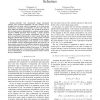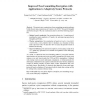130 search results - page 7 / 26 » How to Encrypt with a Malicious Random Number Generator |
CRYPTO
2010
Springer
13 years 4 months ago
2010
Springer
We present a general method to compile any cryptographic algorithm into one which resists side channel attacks of the only computation leaks information variety for an unbounded nu...
ISCAS
2008
IEEE
14 years 2 months ago
2008
IEEE
— Recently four chaos-based image encryption schemes were proposed. Essentially, the four schemes can be classified into one class, which is composed of two basic parts: permuta...
CRYPTO
2007
Springer
14 years 1 months ago
2007
Springer
One day, you suddenly find that a private key corresponding to your Identity is up for sale at e-Bay. Since you do not suspect a key compromise, perhaps it must be the PKG who is...
ASIACRYPT
2009
Springer
14 years 2 months ago
2009
Springer
We present a new construction of non-committing encryption schemes. Unlike the previous constructions of Canetti et al. (STOC ’96) and of Damg˚ard and Nielsen (Crypto ’00), ou...
CHES
2005
Springer
14 years 1 months ago
2005
Springer
Abstract. In this paper, the evaluation of random bit generators for security applications is discussed and the concept of stateless generator is introduced. It is shown how, for t...


